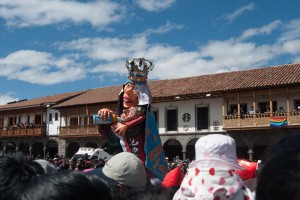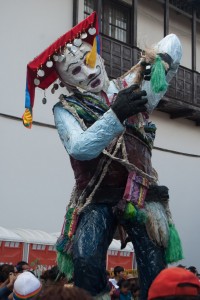The Parade of Allegories and Satire by Fine Arts Students

A giant bull, ridden by a condor, cavorted in Cuzco’s streets this morning. Occasionally it would race towards the audience as if to gore them, and then pull back, while a smaller bull chased a priest. Although dramatic, the bulls and the condor, though not the priest, were papier mache creations of Cuzco’s School of Fine Arts presented in the annual parade of allegories in salute to Cuzco.
The bull and condor were but two of a whole parade of large images, called allegories in Cuzco Spanish. It stretched from the Plaza de Armas to the end of the Sun Avenue and took hours to process through the crowd of engaged spectators. This is one of the important events of this festival month, called Cuzco’s Jubilee, when organization after organization dances or marches by the reviewing stand in front of the Cathedral, registering themselves as members of Cuzco’s society as they salute this Imperial center.

Although called allegories, they might be more properly called representations, or images. They students of different semesters in this important school that trains the future visual artists of the city. They have the task of deciding on an issue of theme and then to design a three dimensional model of it that can parade through the streets, often with parts that move. Not only do they make enormous and fairly complex renditions, they also accompany them with sets of dancers or actors to play roles and locate the piece in peoples’ reality as well as in that of the city. The models must be quickly recognizable as part of the set of images that comprises the city’s universe of representations.
In English, allegory has a somewhat different meaning than in Cuzco’s Spanish, just as two other words used by the announcer to describe them do; parody and satire.
With these words the announcers and organizers take us into the baroque world in which Cuzco’s fiestas first came together. Allegories are like the images of the saints and virgins which are to remind people of the stories of their faith and martyrdom, so they can serve as examples of the Christian life. They also are condensed versions of a historical event or something else socially telling that can remind people of morality and virtue as civic goods.


In colonial Cuzco fiestas often had parades of allegorical carts, carrying three dimensional tableaux. In English we tend to call these floats, as if they floated above the crowd like the images of angels who sit high on baroque altars, as if in the air, or even an image of God floating above everything. However in Cuzco’s Spanish the idea is less about floating as a way of giving transcendence, but about the telling a moral tale.
Today the idea of representation refers less to a story or morality, than it does to a simple act of symbolizing. Representation also recognizes politics and ideologies around the act, but does not see them, per se, as something innate in the image rather than as something given by the artist and critics.
This becomes even clearer with the idea of parody or satire. In English, and formal, contemporary Spanish, these refer to an image, skit, or sketch that makes fun of someone or something. The intent can be entertainment, politics, or more, but that does not matter.
In contrast, the idea in Cuzco Spanish simply reinforces the idea that, like a tableau, they show things that are important about life in Cuzco and its place in the world and cosmos.
While humor is far from absent, it is not the defining mark of the parody or satire. In fact “making fun”, Spanish mofar, seems almost absent. For example, when I got to see the bull up close, I noticed it had a model of a man clinging to its dangling testicles. And in the parade the bull would “urinate” on the crowd. But in this was no act of making fun of a bull, or of a politician or public figure. It seemed more a comment on bulls and their relationship with people, as well as of the lurid comments and jokes of the Andean clowns that often appear in Cuzco’s feasts. It makes a cosmological point.
The bull and condor, with its reference to the Yawar fiesta of Andahuaylas, is only one representation. Others included a rat, a Virgin, an image of the Qolla, the people of highland Puno, ancestors, and so much more. Together they amaze.
Below you can look at some videos of today’s parade.





I’m curious how the huge rat is just an allegory. If I made out the writing on the paper mache briefcase correctly, it says “Basta Al Saqued Gobernantes” (translation: just for sacred rulers?). Sounds political.
I like the idea that the bull is just a representation of the bull’s relationship with people, but is the rat really just a rat?
In some of my other readings it seems like the word “basta” is politicized. David Graeber was part of a group called Ya Basta! which held solidarity with a European collective of Zapatista supporters.
Great article!
You are right, Alonzo. The Spanish says enough of government sacking (our riches). It does make a political comment and is more satirical in the current sense. The rat was a national (and local) government that does not have the interest of ordinary and local people at heart.
But so much else was not so.
Basta is very politicized. All over Latin America.
Thank you for the correction and caution. Hope all is well with you. You are much missed in Cuzco.